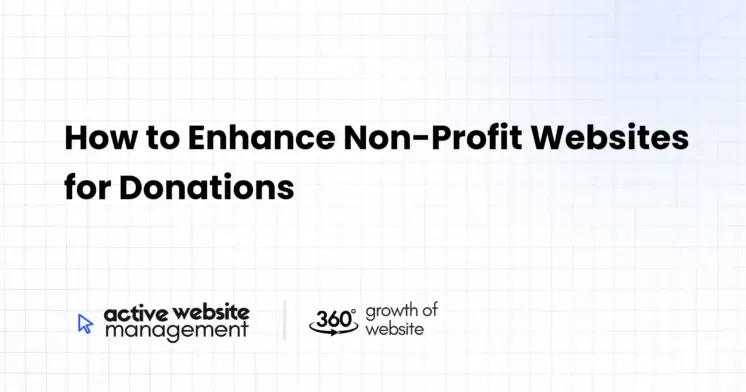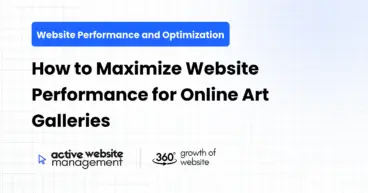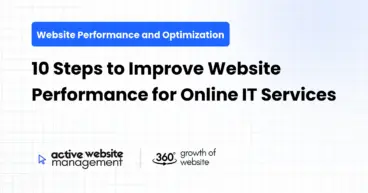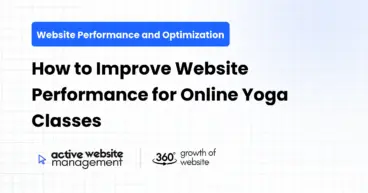January 7, 2025
16 min read
Understanding the Digital Landscape for Non-Profits
The world has gone digital, and for non-profit organizations, this shift presents both challenges and immense opportunities. Your website is no longer just an online brochure; it’s the primary hub for connecting with potential donors, volunteers, and beneficiaries. In the competitive digital arena, charity website optimization is crucial. It’s not enough to simply have a website; it needs to be effective in converting visitors into supporters and, most importantly, donors. We must understand what makes people give and how your online presence can trigger that impulse. This means strategically thinking about your online real estate and ensuring that it’s not just visually appealing, but also optimized for conversions.
Why Website Optimization is Vital for Donations
Why invest time and resources in non-profit SEO tips and website enhancement? Simply put, a well-optimized website significantly increases your visibility, expands your reach, and ultimately, drives more donations. Without a strong online presence, you’re essentially invisible to a vast audience of potential supporters. Here are compelling reasons to prioritize website optimization:
- Increased Visibility: Search engine optimization (SEO) ensures your website appears prominently in search results when people look for charities like yours. More visibility equals more traffic, and ultimately, more donations.
- Enhanced User Experience: A user-friendly website keeps visitors engaged, makes it easy to find information, and guides them towards donation opportunities. A clunky, confusing site will drive visitors away.
- Improved Credibility: A professional, well-maintained website builds trust and legitimacy, demonstrating that your organization is serious and responsible. People are more likely to donate to a trustworthy cause.
- Higher Conversion Rates: Strategically placed calls to action (CTAs), compelling content, and a streamlined donation process can dramatically increase the number of visitors who become donors.
- Cost-Effectiveness: Compared to traditional fundraising methods, a well-optimized website can be a highly cost-effective way to reach a wider audience and generate donations.
- Measurable Results: Digital tools allow you to track website traffic, donor behavior, and the effectiveness of your campaigns, enabling data-driven decision-making.
Key Areas of Website Optimization for Non-Profits
Before diving into specific strategies, it’s crucial to understand the key areas that require focus. These include:
- SEO (Search Engine Optimization): Making sure your website is discoverable by search engines like Google.
- User Experience (UX): Ensuring a smooth, intuitive, and engaging experience for your website visitors.
- Content Optimization: Creating compelling and relevant content that resonates with your target audience and drives action.
- Mobile Optimization: Ensuring your website is responsive and accessible on all devices, including smartphones and tablets.
- Donation Process: Streamlining the donation process to make it easy for people to give.
- Website Speed: Ensuring your site loads quickly and efficiently.
Mastering SEO for Non-Profits
Search Engine Optimization (SEO) is the backbone of online visibility. Without it, your website is like a beautiful storefront hidden in a dark alley. Non-profit SEO tips are crucial for getting your message seen by the people who need to hear it. The goal is to appear on the first page of search engine results when potential donors search for relevant terms.
Don’t Just Maintain Your Website—
Grow It using Active Website Management! Don't Wait for Growth—Accelerate It with Active Website Management
Keyword Research: Finding the Right Terms
The first step in SEO is understanding what terms people use when searching for non-profits like yours. This involves in-depth keyword research. You need to uncover the words and phrases that potential donors are using when searching for charities like yours.
- Brainstorming: Start by listing all the potential keywords and phrases related to your organization’s mission and activities. Think about what your organization does, the causes you support, and the geographic areas you serve.
- Using Keyword Research Tools: Tools like Google Keyword Planner, SEMrush, Ahrefs, and Moz Keyword Explorer can provide valuable data on search volume, competition, and related keywords.
- Long-Tail Keywords: Focus on long-tail keywords, which are longer, more specific phrases (e.g., “donate to help homeless families in New York City” instead of just “donate”). These often have lower competition and attract more targeted traffic.
- Local Keywords: If your organization serves a specific geographic area, include local keywords in your content (e.g., “food bank in Los Angeles”).
On-Page SEO: Optimizing Your Website Content
Once you have your keywords, it’s time to optimize your website content to make it search engine-friendly. This is known as on-page SEO.
- Title Tags and Meta Descriptions: Ensure that every page has a unique and compelling title tag and meta description that includes your target keywords. These snippets are what appear in search results.
- Header Tags (H1, H2, H3): Use header tags to structure your content, incorporating relevant keywords where natural. The H1 tag should be used for the main heading on a page, with H2 and H3 for subheadings.
- Image Optimization: Optimize your images with descriptive filenames and alt text. This helps search engines understand the content of your images.
- Content Quality and Relevance: Create high-quality, engaging content that is relevant to your target audience and incorporates your target keywords naturally.
- Internal Linking: Link to other relevant pages on your website to improve navigation and boost SEO.
- URL Optimization: Create search engine-friendly URLs that include your target keywords.
Off-Page SEO: Building Authority and Trust
Off-page SEO involves building authority and trust for your website through external links and mentions. This is crucial for improving your search engine rankings.
- Link Building: Earn high-quality backlinks from other reputable websites in your industry. This can be through guest blogging, partnerships, or directory listings.
- Social Media Promotion: Promote your website and content on social media to increase visibility and drive traffic.
- Online Directories: List your organization in reputable online directories for non-profits.
- Local Citations: For local non-profits, ensure that your business information is consistent and accurate across all online directories.
- Online Reputation Management: Monitor and manage your online reputation by responding to comments and reviews promptly and professionally.
Crafting a User-Friendly Experience (UX)
A website might be optimized for search engines, but if it’s difficult to use, people will leave. Focusing on User Experience (UX) is paramount. People need to be able to find what they need quickly and easily. This means clear navigation, compelling content, and a streamlined donation process.
Clear and Intuitive Navigation
Website navigation is your roadmap, and it should be easy for visitors to find their way around.
- Simple Menu Structure: Use a clear and concise menu structure with descriptive labels. Avoid jargon or overly technical terms.
- Logical Page Hierarchy: Organize your website pages in a logical way, making it easy to find related information.
- Search Functionality: Include a search bar so visitors can easily find what they’re looking for.
- Breadcrumb Navigation: Use breadcrumbs to show visitors their current location on the website.
- Mobile-Friendly Navigation: Ensure your navigation is easily accessible on all devices, including smartphones and tablets.
Compelling Content: Telling Your Story
The content on your website is crucial for engaging visitors and persuading them to donate. Your message needs to be clear, inspiring, and emotionally resonant.
- Clear Value Proposition: Clearly communicate what your organization does, why it’s important, and the impact you’re making.
- Compelling Storytelling: Share stories of the people or causes that your organization serves. Use photos and videos to bring your story to life.
- Visual Appeal: Use high-quality images and videos to make your content visually engaging and break up large blocks of text.
- Easy to Read: Use headings, subheadings, bullet points, and short paragraphs to make your content easy to scan and digest.
- Call to Action (CTA): Include clear and compelling CTAs that prompt visitors to take action, such as “Donate Now,” “Volunteer Today,” or “Learn More.”
Mobile Optimization: Reaching Everyone
In today’s mobile-first world, a website that isn’t optimized for mobile devices is virtually useless. A mobile-friendly website is no longer optional; it’s essential.
- Responsive Design: Ensure that your website automatically adjusts to fit different screen sizes.
- Fast Loading Times: Optimize images and other elements to ensure that your website loads quickly on mobile devices.
- Easy to Tap: Make sure that buttons and links are large enough and spaced correctly for easy tapping on touchscreens.
- Simplified Content: Present information in a concise and easy-to-read format on smaller screens.
- Test on Different Devices: Regularly test your website on different mobile devices to ensure it’s working correctly.
Website Speed: Keeping Visitors Engaged
Website speed is a crucial factor that can directly impact user experience and conversions. Slow-loading websites frustrate users and encourage them to leave.
- Optimize Images: Compress images to reduce file size without sacrificing quality. Use tools to compress images before uploading to your site.
- Minify Code: Minify HTML, CSS, and JavaScript files to reduce their size. Use online tools to do this.
- Leverage Browser Caching: Use browser caching to store static files locally so they don’t need to be downloaded every time a visitor accesses your site.
- Choose a Reliable Hosting Provider: Select a hosting provider that provides fast and reliable performance.
- Use a Content Delivery Network (CDN): Use a CDN to deliver content from servers located closer to users, resulting in faster loading times.
Optimizing the Donation Process
The donation process is the most crucial part of your website for fundraising. It needs to be easy, secure, and inspire trust. A cumbersome or confusing donation process will deter potential donors, no matter how compelling your cause is.
Don't Wait for Growth—Accelerate It with
Active Website Management Don't Wait for Growth—Accelerate It with Active Website Management
Clear Call to Action (CTA)
Make it crystal clear how visitors can donate. Your CTAs should be highly visible and compelling.
- Prominent Placement: Place CTAs prominently on your homepage, navigation menu, and other relevant pages.
- Compelling Language: Use clear, action-oriented language, such as “Donate Now,” “Give Today,” or “Support Our Mission.”
- Visually Appealing Buttons: Use buttons that are easy to see and tap on all devices.
- Multiple CTAs: Include multiple CTAs throughout your website to increase visibility.
- Urgency and Scarcity: Use phrases like “Donate today and make a difference” or “Your gift will be matched” to create a sense of urgency and encourage donors to give now.
Streamlined Donation Form
A complicated donation form is a major barrier to donations. Make the process as smooth and simple as possible.
- Minimize Form Fields: Only ask for essential information. Avoid asking for too much personal data.
- Easy to Understand Fields: Use clear labels and instructions for each form field.
- Progress Indicator: Show donors how far they are in the process.
- Multiple Payment Options: Offer multiple payment options, such as credit cards, debit cards, PayPal, and other digital wallets.
- Mobile-Friendly Form: Ensure your donation form is easy to use on all devices, including mobile phones.
Secure Payment Gateway
Donors need to feel confident that their payment information is safe. Security is paramount.
- SSL Certificate: Use an SSL certificate to encrypt all data transmitted between the donor’s browser and your website.
- Reputable Payment Gateway: Use a reputable payment gateway that complies with industry security standards.
- Clear Privacy Policy: Clearly state how donor information is collected and used.
- Display Security Badges: Display security badges to reassure donors that their information is protected.
- PCI Compliance: Ensure your payment processor is PCI compliant.
Donation Confirmation and Follow-Up
After a donation is made, it’s important to acknowledge the donor and follow up with a personalized thank-you message.
- Immediate Confirmation: Send an immediate email confirmation to acknowledge the donation.
- Personalized Thank-You: Send a personalized thank-you message expressing gratitude for the donor’s support.
- Impact Report: Share how their donation is making a difference by sharing stories, project updates and impact reports.
- Engagement: Keep in touch with your donors through email newsletters and social media updates.
- Recurring Giving: Encourage donors to make recurring donations to provide a steady stream of support.
Content Marketing for Non-Profits
Content is the currency of the digital world, and for non-profits, it’s a powerful tool for driving engagement, building awareness, and ultimately, generating donations. Effective content marketing should educate, inspire, and compel action.
Blog Posts: Sharing Your Stories
Blog posts are an excellent way to share your organization’s stories, inform your audience about your work, and establish yourself as a thought leader.
- Behind-the-Scenes: Share behind-the-scenes glimpses into your organization’s work.
- Impact Stories: Share compelling stories of the people you are helping, focusing on the positive impact you’re making.
- Educational Content: Provide educational content related to your cause and the problems you’re solving.
- Expert Advice: Share expert advice or interviews with experts in your field.
- Call to Action: Include clear CTAs throughout your blog posts that encourage readers to donate or get involved.
Videos: Engaging Visuals
Video content is a powerful way to engage your audience, as it can be more impactful and memorable than text alone.
- Mission Videos: Create a video that explains your mission, vision, and values.
- Impact Stories: Share stories through video testimonials from the people you’re helping.
- Event Highlights: Create videos that showcase the highlights of your events or fundraising activities.
- Behind the Scenes: Offer behind-the-scenes glimpses of your organization’s work through video.
- Fundraising Appeals: Create a video that asks for donations, explaining what their contribution will achieve.
Infographics: Visualizing Data
Infographics are a great way to present data and statistics in a visually appealing and easy-to-understand format.
- Impact Statistics: Visualize data about your impact to show donors the difference their contribution makes.
- Program Overviews: Create infographics that visually highlight the different programs and services you provide.
- Research Results: Present the results of your research and the findings of your work in an easy to read format.
- Fundraising Goals: Present fundraising goals and progress in an engaging visual format.
- Social Media Sharing: Create infographics that are easily shared on social media.
Email Marketing: Engaging Your Audience
Email marketing is an excellent way to stay in touch with your donors and keep them informed about your organization’s activities.
- Welcome Email Series: Create a welcome email series for new subscribers, introducing them to your organization and its mission.
- Newsletter Updates: Send regular newsletters to keep your subscribers informed about your activities, events, and fundraising goals.
- Impact Reports: Share impact reports with your donors to show them how their contributions are making a difference.
- Personalized Appeals: Create personalized appeals based on donor behavior and preferences.
- Segment Your Audience: Segment your audience based on their interests, engagement level, or donation history for targeted messaging.
Social Media: Expanding Your Reach
Social media is a powerful tool for connecting with potential donors, raising awareness, and driving engagement.
- Platform Choice: Choose the right social media platforms based on your target audience and their preferred channels.
- Compelling Content: Share compelling content, including stories, photos, and videos, that will capture the attention of your followers.
- Engage With Followers: Respond to comments and messages promptly, engage in conversations, and build relationships.
- Paid Advertising: Use paid social media advertising to reach a wider audience and drive donations.
- Run Campaigns: Run targeted campaigns to promote specific fundraising initiatives or events.
Active Website Management: Ensuring Long-Term Success
Maintaining a website isn’t a one-time task; it’s an ongoing process. Consistent monitoring, analysis, and adjustments are crucial for long-term success. Just like a garden, your website requires constant care to thrive. Active Website Management can play a pivotal role in this. They offer services designed to ensure that your website continues to perform optimally.
Website Analytics: Monitoring Performance
Tracking your website’s performance is crucial for identifying what’s working and what needs improvement.
- Google Analytics: Use Google Analytics to track your website traffic, user behavior, and conversion rates.
- Key Metrics: Monitor key metrics such as bounce rate, time on page, pages per session, and conversion rates.
- Identify Bottlenecks: Identify areas of your website that are not performing well and require improvement.
- A/B Testing: Use A/B testing to compare different versions of your website pages and identify what works best.
- Regular Reporting: Create regular reports to track your progress and identify trends.
Website Maintenance: Keeping Things Updated
Regular website maintenance is essential for ensuring your website remains secure, functional, and up-to-date.
- Software Updates: Keep your website’s software, plugins, and themes up-to-date.
- Security Checks: Conduct regular security checks to identify and address any potential vulnerabilities.
- Broken Link Checks: Regularly check for broken links and fix them to ensure a seamless user experience.
- Content Audits: Regularly review your website content to ensure it’s still accurate and relevant.
- Website Backups: Create regular backups of your website to ensure that you can quickly recover if there’s an issue.
Continuous Optimization: Evolving with Best Practices
The digital landscape is constantly evolving, so you need to continually optimize your website to stay ahead of the curve.
- Stay Updated on SEO: Keep up with the latest SEO best practices and adjust your strategy accordingly.
- User Feedback: Actively seek feedback from your website visitors and make changes based on their input.
- Technology Trends: Keep an eye on the latest technology trends and make sure your website is using the most effective tools.
- Competition Analysis: Analyze your competitor’s websites to identify opportunities for improvement.
- Adapt and Iterate: Be willing to adapt your strategies based on data and feedback and constantly refine your approach.
Active Website Management: Your Partner in Growth
For non-profits that lack the resources or expertise to manage their websites effectively, Active Website Management can be a valuable partner. They offer a wide range of services, including:
- Website Maintenance: Ensuring that your website is always up-to-date and functioning correctly.
- SEO Services: Helping your website rank higher in search engine results.
- Content Creation: Creating high-quality, engaging content that will resonate with your audience.
- Website Security: Protecting your website from cyber threats and other security risks.
- Performance Optimization: Improving your website’s speed, user experience, and conversion rates.
Conclusion
Enhancing your non-profit website for donations is not a one-time fix but an ongoing commitment. By focusing on the key areas of SEO, user experience, content optimization, and a streamlined donation process, you can create a powerful online platform that will drive donations and help you achieve your mission. Remember, it’s not just about having a website, it’s about having an effective website that inspires people to give. By implementing the strategies discussed in this article and leveraging resources like Active Website Management plans, you can transform your website into a powerful fundraising tool that will help you make a greater impact. Consistent effort, data analysis, and a willingness to adapt are essential to making your non-profit website a resounding success. Now, go forth and make the world a better place, one donation at a time!







